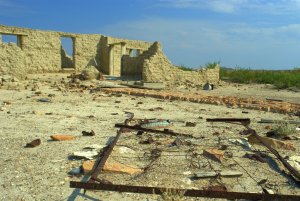 Over 20 years ago, while hiking across a mesa in Big Bend National Park, I found a massive old corral made with dry stacked rock walls that were almost four feet thick and five feet tall. It had obviously taken a great deal of effort to build, and presumably related to the ranching activity that existed in the area prior to the establishment of the national park, but it wasn’t mentioned in any of the park brochures, wasn’t on the park map, and no one I spoke with seemed to have any information about it. Stumbling across old ruins, seemingly in the middle of nowhere, has always fascinated me, and this one really peaked my curiosity, so I started doing a little research. I located a very brief reference to “a Mexican rancher,” but that was the only printed information to be found. An email to the park archeologist finally produced a reply giving the name of the rancher as Federico Villalba, and I found his grave in the Terlingua Ghost Town Cemetary.
Over 20 years ago, while hiking across a mesa in Big Bend National Park, I found a massive old corral made with dry stacked rock walls that were almost four feet thick and five feet tall. It had obviously taken a great deal of effort to build, and presumably related to the ranching activity that existed in the area prior to the establishment of the national park, but it wasn’t mentioned in any of the park brochures, wasn’t on the park map, and no one I spoke with seemed to have any information about it. Stumbling across old ruins, seemingly in the middle of nowhere, has always fascinated me, and this one really peaked my curiosity, so I started doing a little research. I located a very brief reference to “a Mexican rancher,” but that was the only printed information to be found. An email to the park archeologist finally produced a reply giving the name of the rancher as Federico Villalba, and I found his grave in the Terlingua Ghost Town Cemetary.
But who was he? I had heard of and read about Homer Wilson, Sam Nail, J.O. Langford, and other Anglo settlers, but had never heard of a Villalba. Numerous books existed detailing the lives of the Anglo settlers in the area, but not much was mentioned about the Mexican farmers and ranchers who had settled in the area decades earlier. I had unknowingly stumbled across a piece of the park’s cultural history that, until recently, was pretty much invisible. A part of that invisible history is told by Juan Manuel Casas in his book, Federico Villalba’s Texas, the story of his great grandfather. It is a history in which the stories are familiar, but have a slight twist as they are told from the Mexican perspective. It is the story of a man who was a rancher, an entrepreneur, and a store keeper who played a vital role in the life of the Terlingua area, but whom few people today have ever heard of.
It is a history in which the stories are familiar, but have a slight twist as they are told from the Mexican perspective. It is the story of a man who was a rancher, an entrepreneur, and a store keeper who played a vital role in the life of the Terlingua area, but whom few people today have ever heard of.
Since that long ago hike, I’ve visited numerous home sites of Mexican farming and ranching families that were established as early as the mid-1800’s and abandoned when the mercury mines were closed. 

Some of the homes were as simple as a rock walled dugout in the side of hill and others were expansive multi-roomed houses. Some were relatively isolated, and some in small communities. The people who lived in them farmed, ranched, or worked for the mining companies, and are an integral part of the story of Big Bend and Terlingua. I have often sat among the ruins and tried to imagine living there when the stack of rocks was a vibrant home. Thanks to Juan Casas’ book, my imagination has a little help, but I still love to sit and listen to the wind blow across the desert and let my imagination run back in time.



Mylynda, I was browsing the internet this day, and stumbled across your article in Limestone and Lizards. I cruise the internet every so often to see if there are any new references or reviews on my book. I was pleased to find your comments regarding my book and my great-grandfather. The research and writing of my book occupied 10 years of my life. Thankfully, it continues to live on through eyes such as yours. I am presently working on a prequel to Federico Villalba’s Texas. It’s title is Kings and Vaqueros and tells the story of the family in Italy, Spain, Cuba, Mexico and finally Texas. I hope you get to read it as well.
LikeLike
I look forward to reading your latest book. Thoroughly enjoyed the last one, and I’m sure your new one is just as interesting.
LikeLike